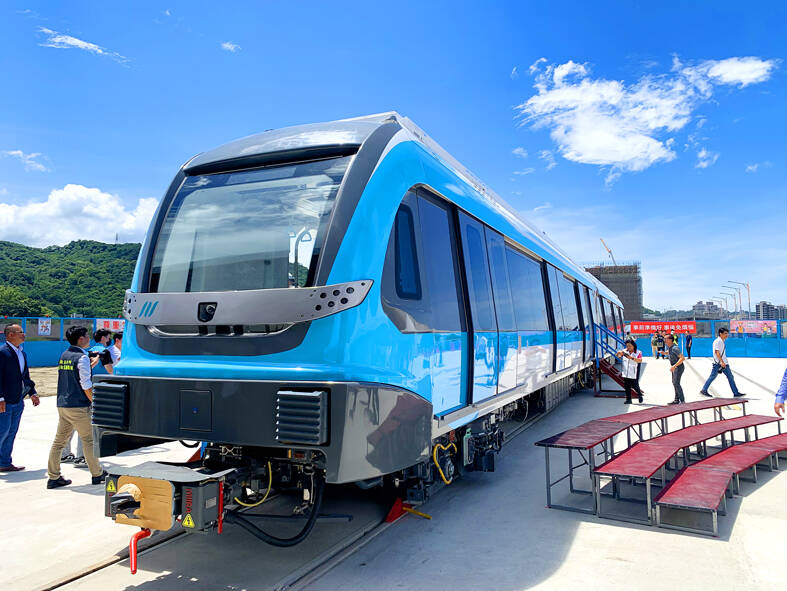Trains for the Sanying light-rail being built in New Taipei City were presented to the media yesterday, which have safety features that were added following a fatal accident on the Taichung MRT in May.
Cameras at the front of each train would work in tandem with an intrusion detection system in the event of an obstruction on the tracks, officials from the New Taipei City Department of Rapid Transit Systems told a news conference in Sansia District (三峽), which the new line is to serve along with Yingge (鶯歌) and Tucheng (土城) districts.
The cameras would allow operators in the control room of the driverless system to view real-time images of trains on the system, the officials said.

Photo: CNA
The cameras were added after an incident on the Taichung MRT on May 10, in which a train plowed into a crane boom that had fallen onto the tracks, killing one passenger, they said.
Other new additions include a more easily accessible emergency stop button, widened gangway connections and a button for platform staff to open train doors to allow an evacuation, the officials said.
A two-car train displayed on Wednesday arrived in Taiwan on Aug. 10 and is the first of 29 units manufactured by Hitachi Rail Italy for use on the Sanying line, which is to connect Dingpu Station on the Taipei MRT Bannan (Blue) Line, the under-construction Taoyuan Metro green line and the MRT Taoyuan Airport Line.
Each train on the 14.29km medium-capacity Sanying line, which is to have 12 elevated stations, has 50 seats and can accommodate a maximum of 330 passengers, the New Taipei City Government said.
The Sanying line is expected to open in 2025, with construction delays pushing the date back from late this year.
Officials attributed the delays to the COVID-19 pandemic and disputes over land expropriations, as well as labor reforms in 2017 limiting the number of hours contractors can work.
Once services begin, travel times between Yingge and Taipei would be reduced by 20 minutes, the department said.

Beijing could eventually see a full amphibious invasion of Taiwan as the only "prudent" way to bring about unification, the US Department of Defense said in a newly released annual report to Congress. The Pentagon's "Annual Report to Congress: Military and Security Developments Involving the People's Republic of China 2025," was in many ways similar to last year’s report but reorganized the analysis of the options China has to take over Taiwan. Generally, according to the report, Chinese leaders view the People's Liberation Army's (PLA) capabilities for a Taiwan campaign as improving, but they remain uncertain about its readiness to successfully seize

Taiwan is getting a day off on Christmas for the first time in 25 years. The change comes after opposition parties passed a law earlier this year to add or restore five public holidays, including Constitution Day, which falls on today, Dec. 25. The day marks the 1947 adoption of the constitution of the Republic of China, as the government in Taipei is formally known. Back then the Chinese Nationalist Party (KMT) governed China from Nanjing. When the KMT, now an opposition party in Taiwan, passed the legislation on holidays, it said that they would help “commemorate the history of national development.” That

Taiwan has overtaken South Korea this year in per capita income for the first time in 23 years, IMF data showed. Per capita income is a nation’s GDP divided by the total population, used to compare average wealth levels across countries. Taiwan also beat Japan this year on per capita income, after surpassing it for the first time last year, US magazine Newsweek reported yesterday. Across Asia, Taiwan ranked fourth for per capita income at US$37,827 this year due to sustained economic growth, the report said. In the top three spots were Singapore, Macau and Hong Kong, it said. South

Snow fell on Yushan (Jade Mountain, 玉山) yesterday morning as a continental cold air mass sent temperatures below freezing on Taiwan’s tallest peak, the Central Weather Administration (CWA) said. Snowflakes were seen on Yushan’s north peak from 6:28am to 6:38am, but they did not fully cover the ground and no accumulation was recorded, the CWA said. As of 7:42am, the lowest temperature recorded across Taiwan was minus-5.5°C at Yushan’s Fengkou observatory and minus-4.7°C at the Yushan observatory, CWA data showed. On Hehuanshan (合歡山) in Nantou County, a low of 1.3°C was recorded at 6:39pm, when ice pellets fell at Songsyue Lodge (松雪樓), a